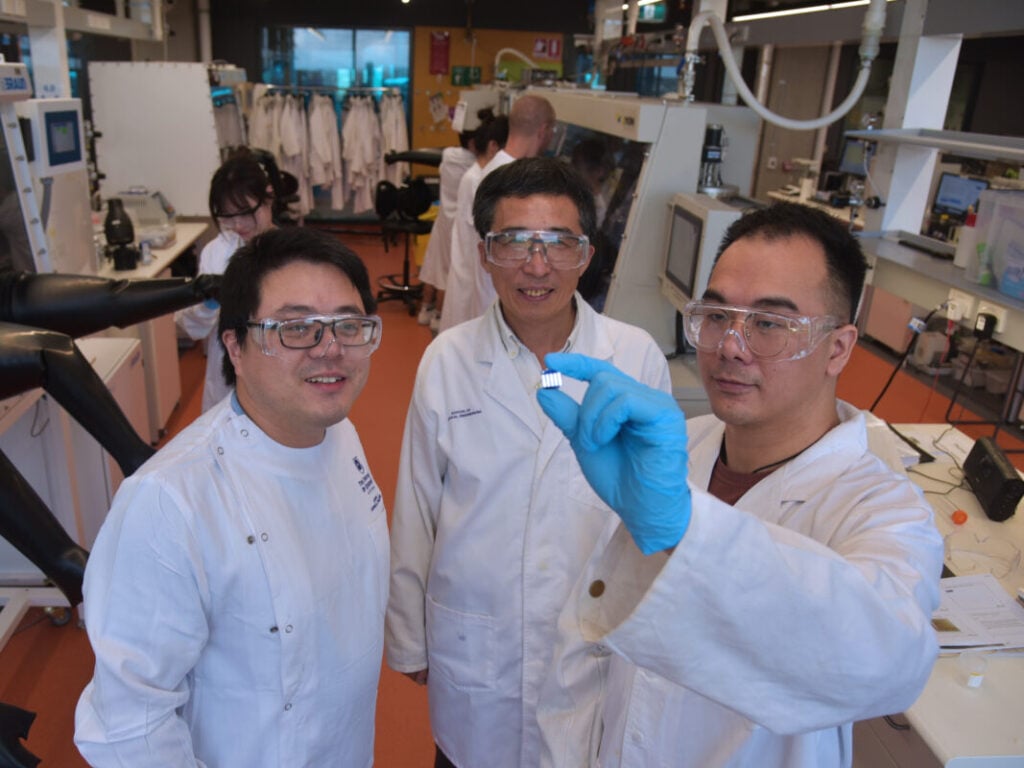
Australia’s University of Queensland has claimed a new world-record efficiency for a tin halide perovskite (THP) solar cell, certified at 16.65%.
The technology, which the university has deemed “eco-friendly perovskite,” utilises a 2D/3D heterojunction architecture. This architecture can effectively regulate crystallisation and suppress defect formation for developing high-quality THP thin films.
Unlock unlimited access for 12 whole months of distinctive global analysis
Photovoltaics International is now included.
- Regular insight and analysis of the industry’s biggest developments
- In-depth interviews with the industry’s leading figures
- Unlimited digital access to the PV Tech Power journal catalogue
- Unlimited digital access to the Photovoltaics International journal catalogue
- Access to more than 1,000 technical papers
- Discounts on Solar Media’s portfolio of events, in-person and virtual
Or continue reading this article for free
The certified record efficiency was achieved by a team led by Professor Lianzhou Wang, comprising researchers from the University of Queensland’s Australian Institute for Bioengineering and Nanotechnology and the School of Chemical Engineering.
Published in the journal nature nanotechnology under the title ‘Homogeneous 2D/3D heterostructured tin halide perovskite photovoltaics’, the researchers disclosed that the solar cell achieved a peak efficiency performance of 17.13% and a certified output of 16.65% under 1,500 hours of continuous one-sun illumination.
Professor Wang said the certified reading achieved by his lab was nearly 1% higher than the previous best for THP solar cells.
“It might not seem like much, but this is a giant leap in a field that is renowned for delicate and incremental progress,” Professor Wang said.
“The reading is in line with many silicon-based solar cells currently on the market, but with the potential to be cheaper and quicker to make. We are thrilled with the record and also to be contributing to the progress of cost-effective renewable energy technology.”
Not only could THP solar cells reduce the cost of PV, but they could also be more sustainable by replacing the often toxic properties of lead with eco-friendly tin. According to the journal entry, THP technology also possesses “desirable optoelectronic properties, which include ideal bandgaps (1.3–1.4 eV), high charge-carrier mobilities and low exciton binding energies.”
Research group member Dr Dongxu He adds that THP solar cells have “great commercial potential” because perovskite devices are more sustainable to produce than silicon-based solar cells.
“The benefit of THP’s is that we’re dealing with more eco-friendly tin and not the toxic lead that is widely used in most of the perovskite solar cells, meaning they can be safely installed around the home,” Dr He said.
Professor Wang stated that the flexibility and versatility of THP cells – when combined with enhanced efficiency – could position them as the ideal candidate for household solar PV modules suitable for both outdoor and indoor use.
“Beyond solar modules, the approach we’ve used in this paper could also be used for other devices that require high-quality perovskite films like lasers, photodetectors, and transistors,” Professor Wang said.
This becomes the latest record in solar cell technology that an Australian institution has achieved this year. In January, a group of scientists and engineers from the University of New South Wales (UNSW) claimed a new world record for photovoltaic efficiency using high-bandgap kesterite solar cells.
The team from UNSW’s School of Photovoltaic and Renewable Energy Engineering announced a best-ever efficiency of 13.2% for high-bandgap kesterite solar cells enhanced with hydrogen. PV Tech Premium recently spoke with Scientia Professor Xiaojing Hao, who led the team behind the breakthrough, as part of our PV Talk offering.







